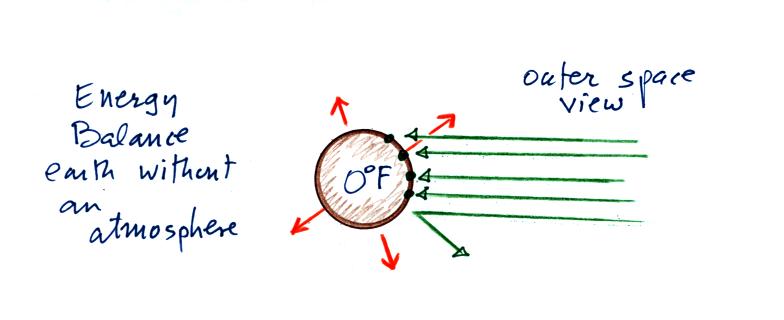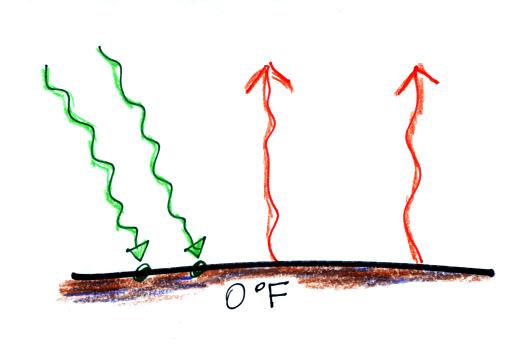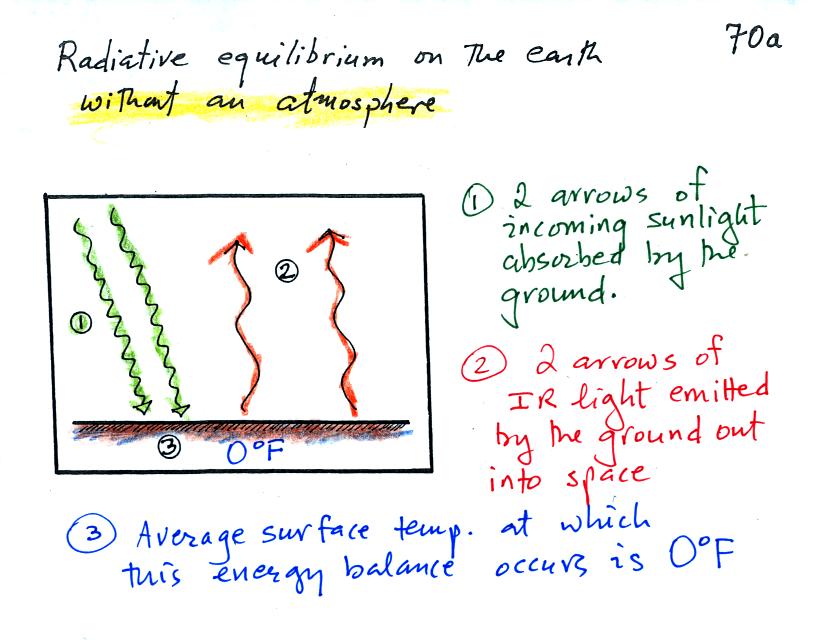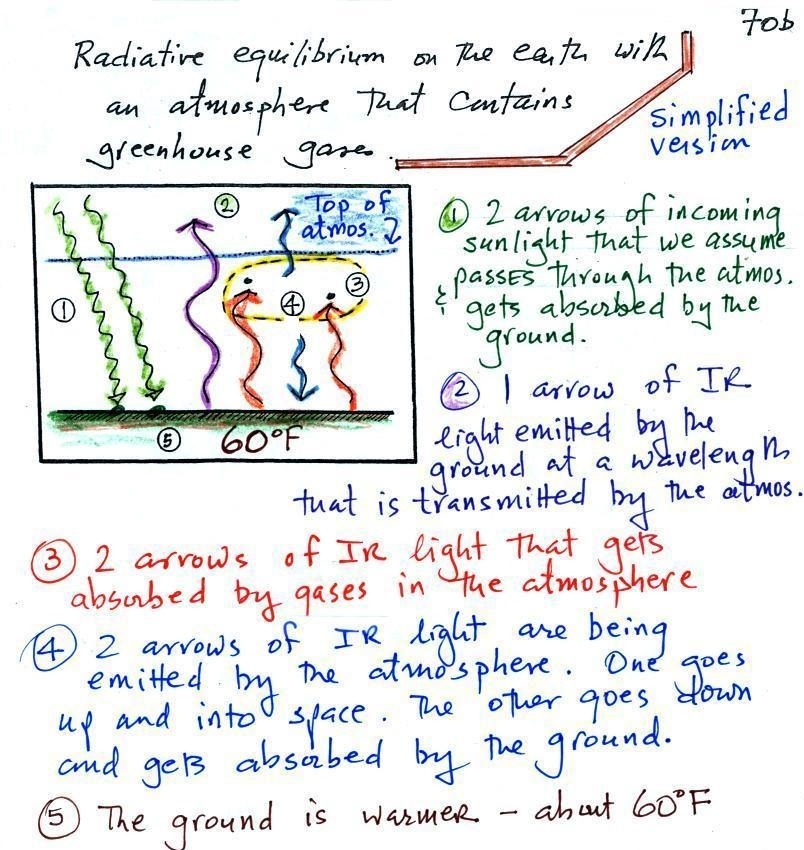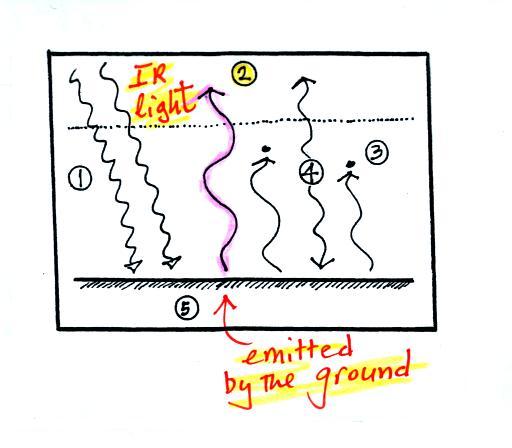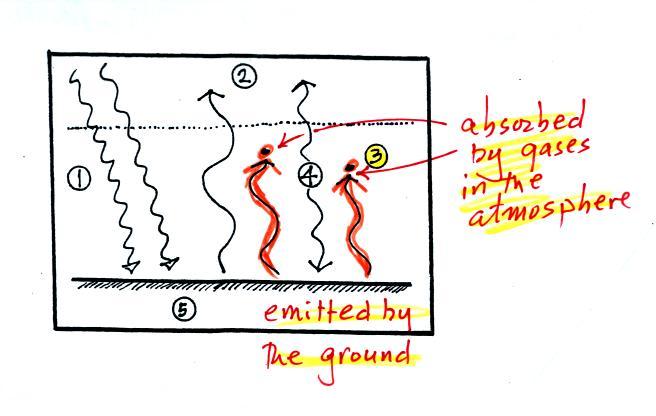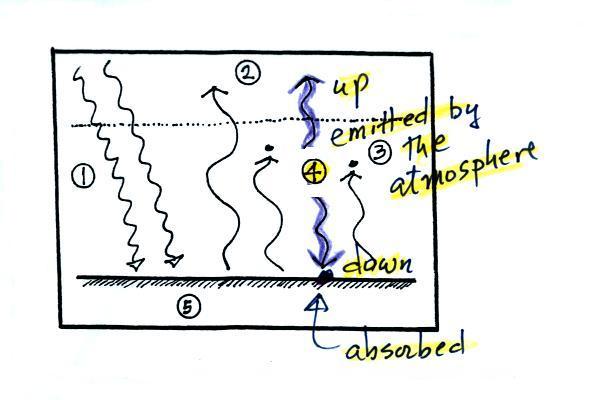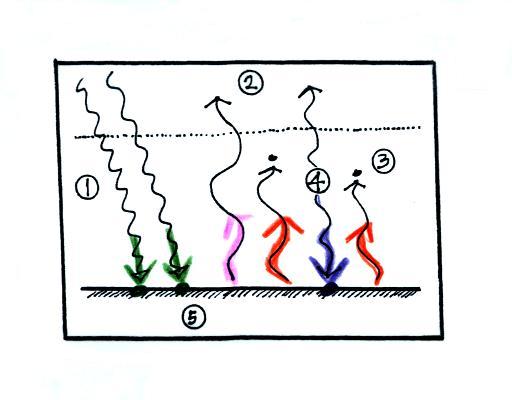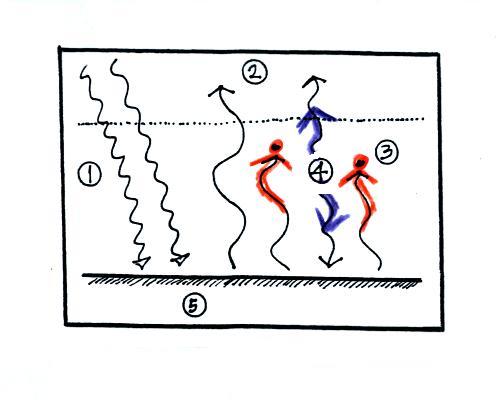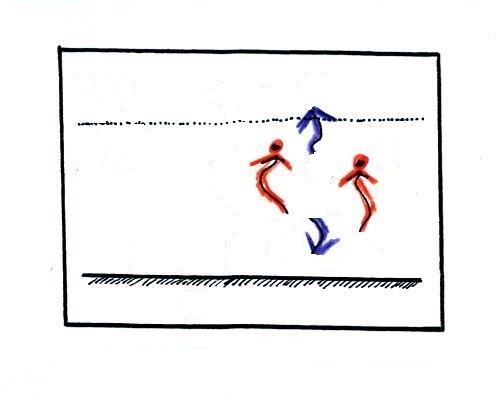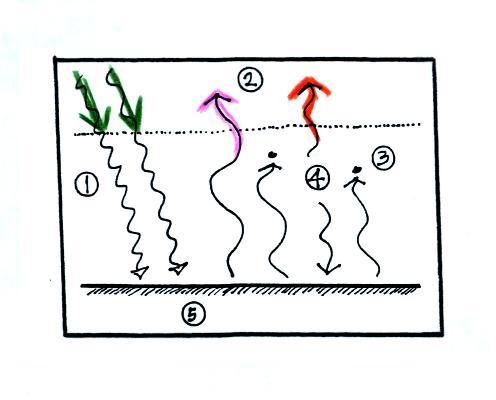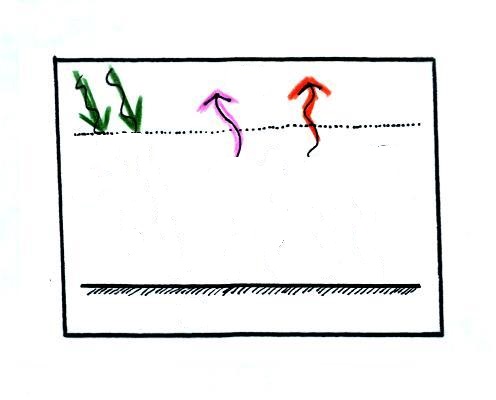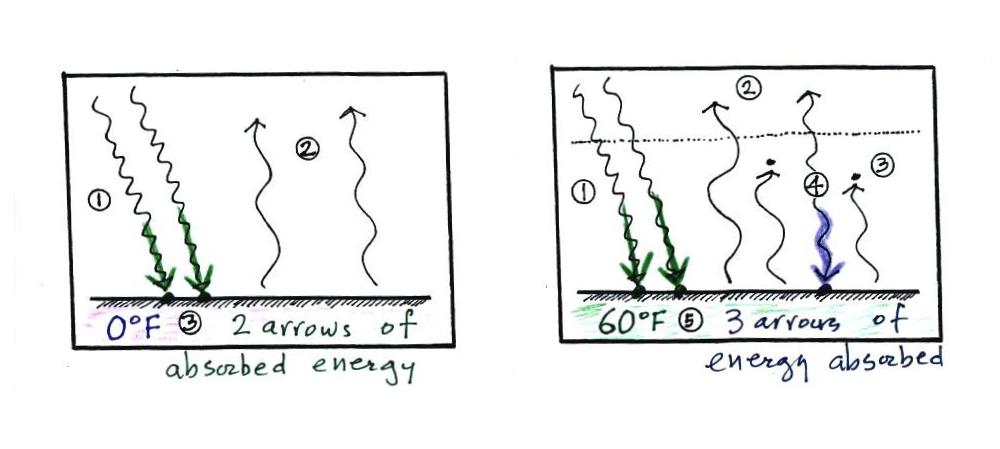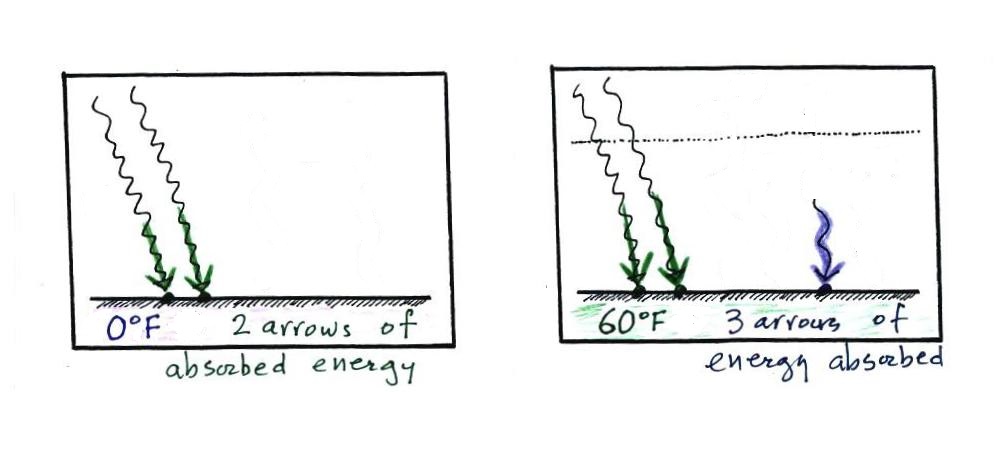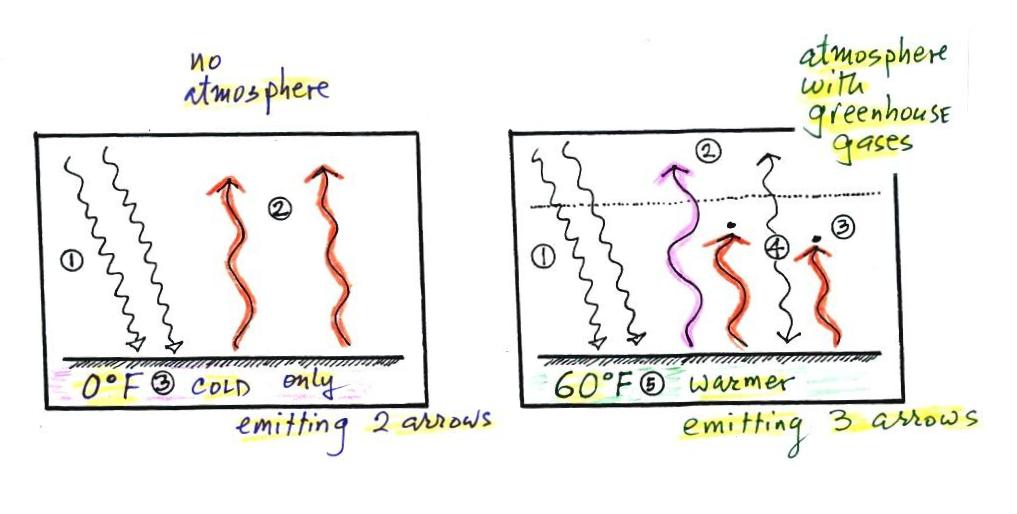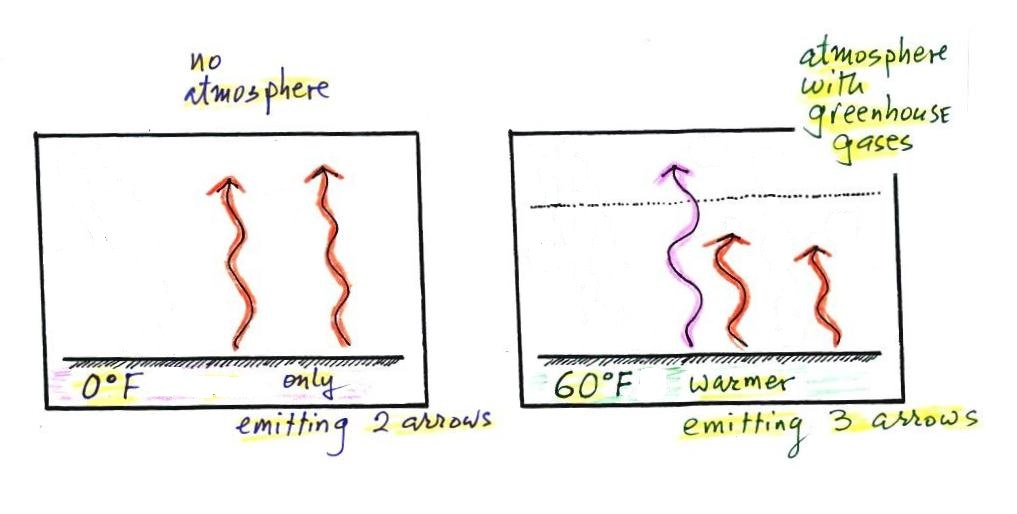Wednesday, Mar. 2, 2016
Janis Joplin "Kozmic Blues"
(4:23), "Little
Girl Blue" (3:51)
We now have most of the tools we will need to begin to study
radiant energy balance on the earth. It will be a balance
between incoming sunlight energy and outgoing IR radiation emitted
by the earth. This will ultimately lead us to an explanation
of the atmospheric greenhouse effect.
Radiative equilibrium on the earth without an atmosphere
We will first look at the simplest kind of situation, the earth
without an atmosphere (or at least an atmosphere without
greenhouse gases). The next figure is on p. 68 in the
ClassNotes. Radiative equilibrium is really just balance
between incoming and outgoing radiant energy.
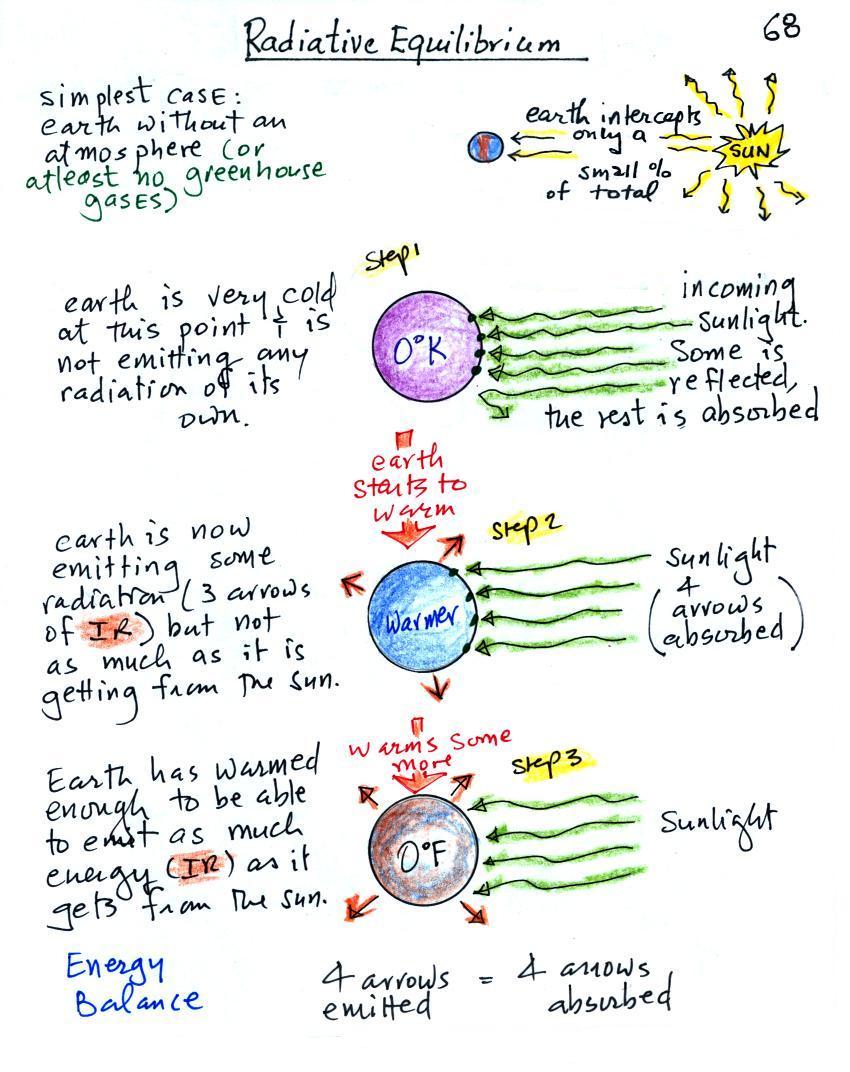
You might first wonder how it is possible for the relatively small
and cool earth (with a temperature of around 300 K) to be in
energy balance with the much larger and hotter sun (6000 K).
Every square foot of the sun emits 160,000 times as much energy as
a square foot on the earth. At the top right of the figure,
however, you can see that because the earth is located about 90
million miles from the sun and only absorbs a very tiny fraction
of the total energy emitted by the sun. The earth only needs
to balance the energy it absorbs from the sun.
To understand how energy balance occurs we start, in Step #1,
by imagining that the earth starts out very cold (0 K) and is not
emitting any EM radiation at all. It is absorbing sunlight
however (4 of the 5 arrows of incoming sunlight in the
first picture are absorbed, 1 of the arrows is being reflected) so
it will begin to warm This is like opening a bank account,
the balance will start at zero. But then you start making
deposits and the balance starts to grow.
Once the earth starts to warm it will also begin to emit EM
radiation, though not as much as it is getting from the sun (the
slightly warmer earth in the middle picture is now colored
blue). Only the four arrows of incoming sunlight that are
absorbed are shown in the middle figure. The arrow of
reflected sunlight has been left off because it doesn't really
play a role in energy balance (reflected sunlight is
like a check that bounces - it really doesn't affect your bank
account balance). The earth is emitting 3 arrows
of IR light (in red). Because the earth is still
gaining more energy (4 arrows) than it is losing (3 arrows) the
earth will warm some more. Once you find money in
your bank account you start to spend it. But as long as
deposits are greater than the withdrawals the balance will grow.
Eventually the earth will warm enough that it (now shaded brown
& blue) will emit the same amount of energy as it absorbs from
the sun. This is radiative equilibrium, energy balance (4
arrows of absorbed energy are balanced by 4 arrows of emitted
energy). That is called the temperature of radiative
equilibrium (it's about 0 F for the earth).
Note that it is the amounts of energy, not the kinds of energy
that are important. Emitted radiation may have a different
wavelength than the absorbed energy. That doesn't
matter. As long as the amounts are the same the earth will
be in energy balance. Someone might deposit money into your
bank account in Euros while you spend dollars.
Filtering effect of the atmosphere on ultraviolet, visible,
and infrared light
Before we start to look at radiant energy balance on the earth
with an atmosphere we need to learn about how the atmosphere will
affect the incoming sunlight (a mixture of UV, visible, and
near IR light) and outgoing far IR light emitted by the
earth. We'll draw a filter absorption graph for the earth's
atmosphere.
We will first look at the effects simple blue, green,
and red glass filters have on visible light. This is just to
be sure we understand what an absorption curve
represents.

If you try to shine white light (a mixture
of all the colors) through a blue filter, only the blue light
passes through. The filter absorption curve shows 100%
absorption at all but a narrow range of wavelengths that
correspond to blue light. The location of the slot or
gap in the absorption curve shifts a little bit to the right
with the green and further right with the red filter.
The following figure is a simplified,
easier to remember, representation of the filtering effect of
the atmosphere on UV, VIS, and IR light (found on p. 69 in the
photocopied notes). The figure was redrawn after class.
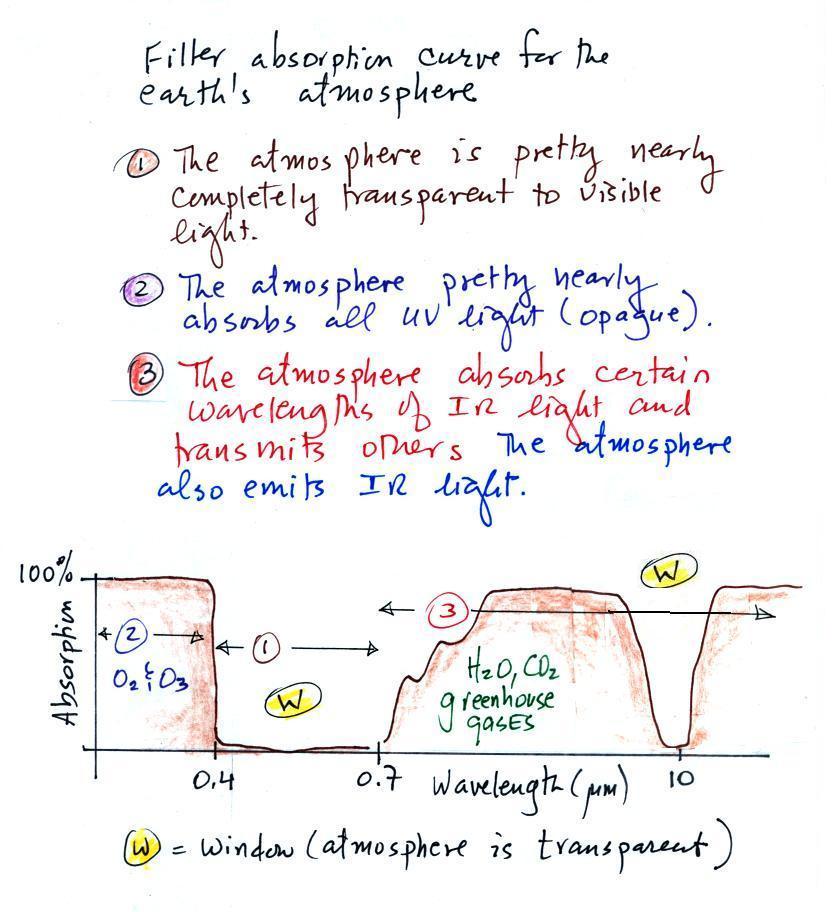
1. You can use your own
eyes to tell you what effect the atmosphere has on visible
light. Air is clear, it is transparent. The
atmosphere transmits visible light.
2. In our simplified representation oxygen
and ozone make the atmosphere pretty nearly completely opaque
to UV light (opaque is the opposite of transparent and means
that light is blocked or absorbed; light can't pass through an
opaque material). We assume that the atmosphere absorbs
all incoming UV light, none of it makes it to the
ground. This is of course not entirely realistic.
3. Greenhouse gases make the atmosphere a
selective absorber of IR light - the air absorbs certain IR
wavelengths and transmits others .
Wavelengths between 0.7 and 8 or 9 μm
are absorbed (by greenhouse gases), radiation centered at 10μm
is transmitted by the atmosphere. Wavelengths greater
than 10 μm are absorbed
(again by greenhouse gases). It is the atmosphere's
ability to absorb certain wavelengths of infrared light that
produces the greenhouse effect and warms the surface of the
earth. The atmosphere also emits IR radiation.
This is also an important part of the greenhouse effect.
Note "the atmospheric window" centered at 10 micrometers. Light emitted by
the earth at this wavelength (and remember 10 um is the
wavelength of peak emission for the earth) will pass through
the atmosphere. Another transparent region, another
window, is found in the visible part of the spectrum.
Now back to the outer space view of radiative equilibrium on
the earth without an atmosphere. The important thing to note
is that the earth is absorbing and emitting the same amount of
energy (4 arrows absorbed balanced by 4 arrows emitted). The
arrow of reflected sunlight doesn't any role at all.
We will be moving from outer space to the earth's surface (the
next two figures below).
Don't let the fact that there are
4 arrows are
being absorbed and emitted in the figure above and
2 arrows absorbed and emitted in the bottom figure below
bother you. The important thing is that there are equal
amounts being absorbed and emitted in both cases.
The reason for only using two
arrows in this picture is to keep the picture as simple as
possible. It will get complicated enough when we add the
atmosphere to the picture.
Here's basically the same
picture, this is the one that is in the ClassNotes (p.
70a). There's a little explanation added.
Radiative equilibrium on the earth with an atmosphere
- the greenhouse effect
The next step is to add the atmosphere.
We will study a
simplified version of radiative equilibrium just so
you can identify and understand the various parts of the
picture. Keep an eye out for the greenhouse
effect. Here's a cleaned up version of what we
ended up with in class. Energy balance is a little more
complex in this case, there are more arrows to sort out.
It would be hard to sort through and try
to understand all of this if you weren't in class (difficult
enough even if you were in class). So below we will go
through it again step by step (which you are free to skip
over if you wish). Caution: some of the colors
below may be different from those used in class.
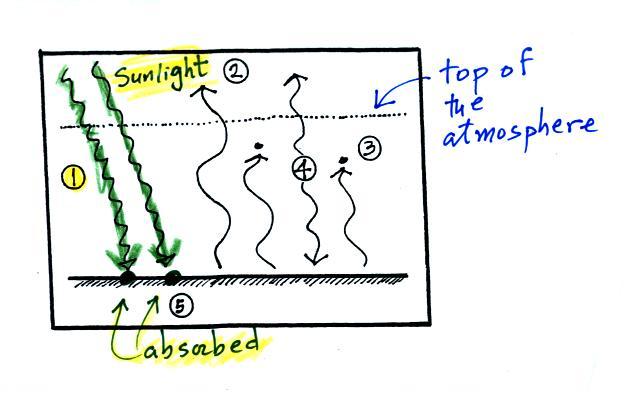
1. In
this picture we see the two rays of incoming sunlight that
pass through the atmosphere, reach the ground, and are
absorbed. 100% of the incoming sunlight is
transmitted by the atmosphere. This wouldn't be too
bad of an assumption if sunlight were just visible
light. But it is not, sunlight is about half IR
light and some of that is going to be absorbed. But
we won't worry about that at this point.
The ground is emitting
a total of 3 arrows of IR radiation. That might seem
like a problem. How can the earth emit 3 arrows when
it is absorbing only 2 from the sun. We'll see how
this can happen in a second.
2. One
of
these
(the
pink
or
purple
arrow
above)
is
emitted
by
the
ground
at
a
wavelength
that
is
not absorbed
by greenhouse gases in the atmosphere (probably around 10
micrometers, in the center of the "atmospheric
window"). This radiation passes through the atmosphere
and goes out into space.
3. The other 2 units of IR radiation emitted
by the ground are absorbed by
greenhouse gases is the atmosphere.
4.
The atmosphere is absorbing 2 units of radiation.
In order to be in radiative equilibrium, the atmosphere must
also emit 2 units of radiation. That's shown
above. 1 unit of IR radiation is sent upward into
space, 1 unit is sent downward to the ground where it is
absorbed. This is probably the part of the picture
that most students have the most trouble visualizing (it
isn't so much that they have trouble understanding that the
atmosphere emits radiation but that 1 arrow is emitted
upward and another is emitted downward toward the
ground). Both arrows leave the atmosphere, one goes
out into space and the other goes into the ground.
Now that all the arrows are accounted for, we will check to be
sure that every part of this picture is in energy balance.
Checking for energy balance
at the ground.
It might help to cover up all but the
bottom part of the picture with a blank sheet of paper
(that's what I tried to do in the right figure below).
The ground is absorbing 3 units
of energy (2 green arrows of sunlight and one blue arrow
coming from the atmosphere) and emitting 3 units of energy
(one pink and two red arrows). The ground is
in energy balance. The earth
emits more energy than it gets from the sun. It can do this
because it gets energy from the atmosphere.
Checking for energy balance in the
atmosphere
The atmosphere is absorbing 2 units of energy (the
2 red arrows coming from the ground) and emitting 2 units of
energy (the 2 blue arrows). One goes upward into
space. The downward arrow goes all the way to the ground
where it gets absorbed (it leaves the atmosphere and gets
absorbed by the ground). We don't care where the arrows
are coming from or where they are going. We are just
interested in the amounts of energy gained and lost by the
atmosphere. The atmosphere is in energy balance.
And we should check to be sure equal amounts
of energy are arriving at and leaving the earth.
2 units of energy arrive at the
top of the atmosphere (green) from the sun after traveling
through space, 2 units of energy (pink and orange) leave
the earth and head back out into space. Energy
balance here too.
Did you spot the greenhouse effect?
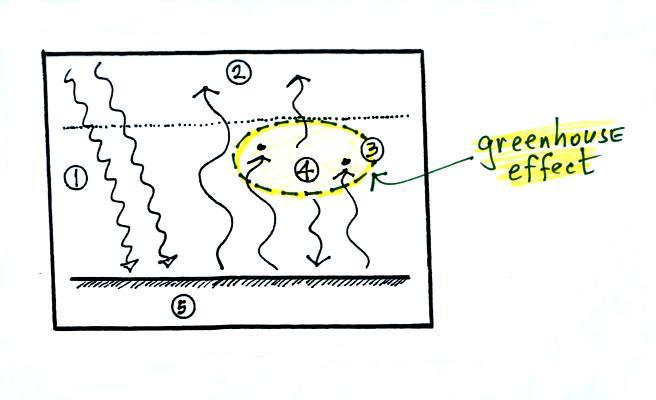
It's Points 3 &
4 in the figure. The greenhouse effect depends on both
absorbing IR radiation and emitting IR
radiation. Here's how you might put it into
words.

This
is as far as we got in class today. We'll cover
the information that follows at the start of class on
Friday.
The greenhouse effect warms the
earth's surface. The global annual average surface
temperature is about 60 F on the earth with a greenhouse
effect. It would be about 0 F without the greenhouse effect.
Here are a couple other ways of understanding why/how the
greenhouse effect warms the earth.
The
picture at left is the earth without an atmosphere
(without a greenhouse effect). At right the earth
has an atmosphere, one that contains greenhouse
gases.
Here we have removed all but the
energy arriving at the ground. At left the ground
is getting 2 units of energy (from the sun). At
right it is getting three, two from the sun and one from
the atmosphere (thanks to the greenhouse effect).
Doesn't it seem reasonable that ground that absorbs 3
units of energy will end up warmer than ground that is
only absorbing 2?
The next picture shows an even better (but more subtle) way of
analyzing the situation.
And again we'll simplify the picture by removing
all but the emitted energy.
To be in energy balance, the ground in the picture above at
left must emit 2 arrows of radiant energy.
At right the ground has to somehow send 2 units of IR energy
back into space. The ground "knows" that some of what it
emits will be returned to the ground (some of what the ground
emits is absorbed by the atmosphere and sent (emitted) back to
the ground because of the greenhouse effect). So the
ground emits a "little extra" (3 units) so that 2 units can
escape into space.
The amount of energy emitted by an object depends on
temperature (to the 4th power). The Stefan-Boltzmann
laws tell us that. So to be able to emit 3 units of IR
energy the ground has to be warmer than if it only has to emit
2 units of energy.




